Hydroquinone-Based Fabrication of Gold Nanorods with a High Aspect Ratio and LSPR Greater than 850 nm to Be Used as a Surface Plasmon Resonance Platform for Rapid Detection of Thiophanate Methyl
Abstract
1. Introduction
2. Materials and Methods
2.1. Chemicals and Characterization
2.2. Synthesis of Au Nanoseeds and AuNRs
2.3. SERS Measurement
3. Results and Discussion
3.1. Growth of Au Nanoseeds into AuNRs
3.2. Detection of Fungicides on a SERS-Based Sensing Platform
4. Conclusions
Author Contributions
Funding
Acknowledgments
Conflicts of Interest
References
- Pyrzynska, K. Nanomaterials in speciation analysis of metals and metalloids. Talanta 2020, 212, 120784. [Google Scholar] [CrossRef] [PubMed]
- Daniel, M.-C.; Astruc, D. Gold nanoparticles: Assembly, supramolecular chemistry, quantum-size-related properties, and applications toward biology, catalysis, and nanotechnology. Chem. Rev. 2004, 104, 293–346. [Google Scholar] [CrossRef] [PubMed]
- Dykman, L.A.; Khlebtsov, N.G. Gold nanoparticles in biology and medicine: Recent advances and prospects. Acta Nat. (англoязычная версия) 2011, 3, 34–35. [Google Scholar]
- Pacheco-Londono, L.C.; Aparicio-Bolano, J.; Primera-Pedrozo, O.M.; Hernandez-Rivera, S.P. Growth of Ag, Au, Cu, and Pt nanostructures on surfaces by micropatterned laser-image formations. Appl. Opt. 2011, 50, 4161–4169. [Google Scholar] [CrossRef] [PubMed]
- Li, X.; Zhang, S.; Yu, Z.; Yang, T. Surface-enhanced Raman spectroscopic analysis of phorate and fenthion pesticide in apple skin using silver nanoparticles. Appl. Spectrosc. 2014, 68, 483–487. [Google Scholar] [CrossRef]
- Huong Nguyen, T.; Dai Hai, N.; Minh Thanh, V.; Huynh Nhu, T.; Linh Phuong Pham, T.; Ngoc-Tram, N.-T.; Thuy Trang Le, N.; Minh-Tri, N.-L. Fabrication Process and Characterization of AgNPs/PVA/ Cellulose as a SERS Platform for In-situ Detection of Residual Pesticides in Fruit. Mater. Res. Express 2020, 7, 035019. [Google Scholar] [CrossRef]
- Tuan Anh, M.N.; Nguyen, D.T.D.; Ke Thanh, N.V.; Phuong Phong, N.T.; Nguyen, D.H.; Nguyen-Le, M.-T. Photochemical Synthesis of Silver Nanodecahedrons under Blue LED Irradiation and Their SERS Activity. Processes 2020, 8, 292. [Google Scholar] [CrossRef]
- Liu, X.; Dai, Q.; Austin, L.; Coutts, J.; Knowles, G.; Zou, J.; Chen, H.; Huo, Q. A One-Step Homogeneous Immunoassay for Cancer Biomarker Detection Using Gold Nanoparticle Probes Coupled with Dynamic Light Scattering. J. Am. Chem. Soc. 2008, 130, 2780–2782. [Google Scholar] [CrossRef]
- Khlebtsov, N.G.; Melnikov, A.G.; Dykman, L.A.; Bogatyrev, V.A. Optical Properties and Biomedical Applications of Nanostructures Based on Gold and Silver Bioconjugates. In Proceedings of the Photopolarimetry in Remote Sensing, Dordrecht, The Netherlands, 20 September–4 October 2003; pp. 265–308. [Google Scholar]
- Russier-Antoine, I.; Huang, J.; Benichou, E.; Bachelier, G.; Jonin, C.; Brevet, P.-F. Hyper Rayleigh scattering of protein-mediated gold nanoparticles aggregates. Chem. Phys. Lett. 2008, 450, 345–349. [Google Scholar] [CrossRef]
- Kamnev, A.A.; Dykman, L.A.; Tarantilis, P.A.; Polissiou, M.G. Spectroimmunochemistry Using Colloidal Gold Bioconjugates. Biosci. Rep. 2002, 22, 541–547. [Google Scholar] [CrossRef]
- Lin, C.-C.; Yang, Y.-M.; Chen, Y.-F.; Yang, T.-S.; Chang, H.-C. A new protein A assay based on Raman reporter labeled immunogold nanoparticles. Biosens. Bioelectron. 2008, 24, 178–183. [Google Scholar] [CrossRef] [PubMed]
- Kim, J.E.; Choi, J.H.; Colas, M.; Kim, D.H.; Lee, H. Gold-based hybrid nanomaterials for biosensing and molecular diagnostic applications. Biosens. Bioelectron. 2016, 80, 543–559. [Google Scholar] [CrossRef] [PubMed]
- Ye, K.; Li, K.; Lu, Y.; Guo, Z.; Ni, N.; Liu, H.; Huang, Y.; Ji, H.; Wang, P. An overview of advanced methods for the characterization of oxygen vacancies in materials. TrAC Trends Anal. Chem. 2019, 116, 102–108. [Google Scholar] [CrossRef]
- Thygesen, L.G.; Jorgensen, K.; Moller, B.L.; Engelsen, S.B. Raman spectroscopic analysis of cyanogenic glucosides in plants: Development of a flow injection surface-enhanced Raman scatter (FI-SERS) method for determination of cyanide. Appl. Spectrosc. 2004, 58, 212–217. [Google Scholar] [CrossRef] [PubMed]
- Baia, L.; Baia, M.; Popp, J.; Astilean, S. Gold films deposited over regular arrays of polystyrene nanospheres as highly effective SERS substrates from visible to NIR. J. Phys. Chem. B 2006, 110, 23982–23986. [Google Scholar] [CrossRef]
- Luty-Błocho, M.; Fitzner, K.; Hessel, V.; Löb, P.; Maskos, M.; Metzke, D.; Pacławski, K.; Wojnicki, M. Synthesis of gold nanoparticles in an interdigital micromixer using ascorbic acid and sodium borohydride as reducers. Chem. Eng. J. 2011, 171, 279–290. [Google Scholar] [CrossRef]
- Dozol, H.; Mériguet, G.; Ancian, B.; Cabuil, V.r.; Xu, H.; Wang, D.; Abou-Hassan, A. On the synthesis of Au nanoparticles using EDTA as a reducing agent. J. Phys. Chem. C 2013, 117, 20958–20966. [Google Scholar] [CrossRef]
- Huang, X.; El-Sayed, I.H.; Qian, W.; El-Sayed, M.A. Cancer cell imaging and photothermal therapy in the near-infrared region by using gold nanorods. J. Am. Chem. Soc. 2006, 128, 2115–2120. [Google Scholar] [CrossRef]
- Morasso, C.; Picciolini, S.; Schiumarini, D.; Mehn, D.; Ojea-Jiménez, I.; Zanchetta, G.; Vanna, R.; Bedoni, M.; Prosperi, D.; Gramatica, F. Control of size and aspect ratio in hydroquinone-based synthesis of gold nanorods. J. Nanopart. Res. 2015, 17, 330. [Google Scholar] [CrossRef]
- Orendorff, C.J.; Gearheart, L.; Jana, N.R.; Murphy, C.J. Aspect ratio dependence on surface enhanced Raman scattering using silver and gold nanorod substrates. Phys. Chem. Chem. Phys. 2006, 8, 165–170. [Google Scholar] [CrossRef] [PubMed]
- Jana, N.R.; Gearheart, L.; Murphy, C.J. Evidence for Seed-Mediated Nucleation in the Chemical Reduction of Gold Salts to Gold Nanoparticles. Chem. Mater. 2001, 13, 2313–2322. [Google Scholar] [CrossRef]
- Jiang, X.C.; Brioude, A.; Pileni, M.P. Gold nanorods: Limitations on their synthesis and optical properties. Colloids Surf. A Physicochem. Eng. Asp. 2006, 277, 201–206. [Google Scholar] [CrossRef]
- Vigderman, L.; Zubarev, E.R. High-Yield Synthesis of Gold Nanorods with Longitudinal SPR Peak Greater than 1200 nm Using Hydroquinone as a Reducing Agent. Chem. Mater. 2013, 25, 1450–1457. [Google Scholar] [CrossRef]
- OEHHA. Proposition 65 Maximum Allowable Dose Level (madl) for Reproductive Toxicity for Thiophanate-Methyl for the Oral Route of Exposure; OEHHA: Sacramento, CA, USA, 2004.
- OEHHA. Chemicals Known to the State to Cause Cancer or Reproductive Toxicity; OEHHA: Sacramento, CA, USA, 2018.
- Galán-Cano, F.; Lucena, R.; Cárdenas, S.; Valcárcel, M. Dispersive micro-solid phase extraction with ionic liquid-modified silica for the determination of organophosphate pesticides in water by ultra performance liquid chromatography. Microchem. J. 2013, 106, 311–317. [Google Scholar] [CrossRef]
- Yan, X.; Li, H.; Hu, T.; Su, X. A novel fluorimetric sensing platform for highly sensitive detection of organophosphorus pesticides by using egg white-encapsulated gold nanoclusters. Biosens. Bioelectron. 2017, 91, 232–237. [Google Scholar] [CrossRef]
- Yi, Y.; Zhu, G.; Liu, C.; Huang, Y.; Zhang, Y.; Li, H.; Zhao, J.; Yao, S. A Label-Free Silicon Quantum Dots-Based Photoluminescence Sensor for Ultrasensitive Detection of Pesticides. Anal. Chem. 2013, 85, 11464–11470. [Google Scholar] [CrossRef]
- Gans, R. Über die form ultramikroskopischer silberteilchen. Ann. Phys. 1915, 352, 270–284. [Google Scholar] [CrossRef]
- Huang, X.; Neretina, S.; El-Sayed, M.A. Gold nanorods: From synthesis and properties to biological and biomedical applications. Adv. Mater. 2009, 21, 4880–4910. [Google Scholar] [CrossRef]
- Chang, C.-C.; Wu, H.-L.; Kuo, C.-H.; Huang, M.H. Hydrothermal Synthesis of Monodispersed Octahedral Gold Nanocrystals with Five Different Size Ranges and Their Self-Assembled Structures. Chem. Mater. 2008, 20, 7570–7574. [Google Scholar] [CrossRef]
- Esparza, R.; Rosas, G.; López Fuentes, M.; Sánchez Ramírez, J.F.; Pal, U.; Ascencio, J.A.; Pérez, R. Synthesis of gold nanoparticles with different atomistic structural characteristics. Mater. Charact. 2007, 58, 694–700. [Google Scholar] [CrossRef]
- Koeppl, S.; Solenthaler, C.; Caseri, W.; Spolenak, R. Towards a Reproducible Synthesis of High Aspect Ratio Gold Nanorods. J. Nanomater. 2011, 2011, 515049. [Google Scholar] [CrossRef]
- Brioude, A.; Jiang, X.C.; Pileni, M.P. Optical Properties of Gold Nanorods: DDA Simulations Supported by Experiments. J. Phys. Chem. B 2005, 109, 13138–13142. [Google Scholar] [CrossRef] [PubMed]
- Kaur, P.; Chudasama, B. Seedless co-surfactant-based dimensional and optical tunability of gold nanorods with simultaneous pH regulation. J. Mater. Sci. 2017, 52, 11675–11687. [Google Scholar] [CrossRef]
- Shah, A.B.; Sivapalan, S.T.; DeVetter, B.M.; Yang, T.K.; Wen, J.; Bhargava, R.; Murphy, C.J.; Zuo, J.-M. High-Index Facets in Gold Nanocrystals Elucidated by Coherent Electron Diffraction. Nano Lett. 2013, 13, 1840–1846. [Google Scholar] [CrossRef] [PubMed]
- Chen, H.; Shao, L.; Li, Q.; Wang, J. Gold nanorods and their plasmonic properties. Chem. Soc. Rev. 2013, 42, 2679–2724. [Google Scholar] [CrossRef] [PubMed]
- Ogundare, O.D.; Akinribide, O.J.; Adetunji, A.R.; Adeoye, M.O.; Olubambi, P.A. Crystallite size determination of thermally deposited Gold Nanoparticles. Procedia Manuf. 2019, 30, 173–179. [Google Scholar] [CrossRef]
- Socrates, G. Infrared and Raman Characteristic Group Frequencies: Tables and Charts; John Wiley & Sons: Chichester, UK, 2004. [Google Scholar]



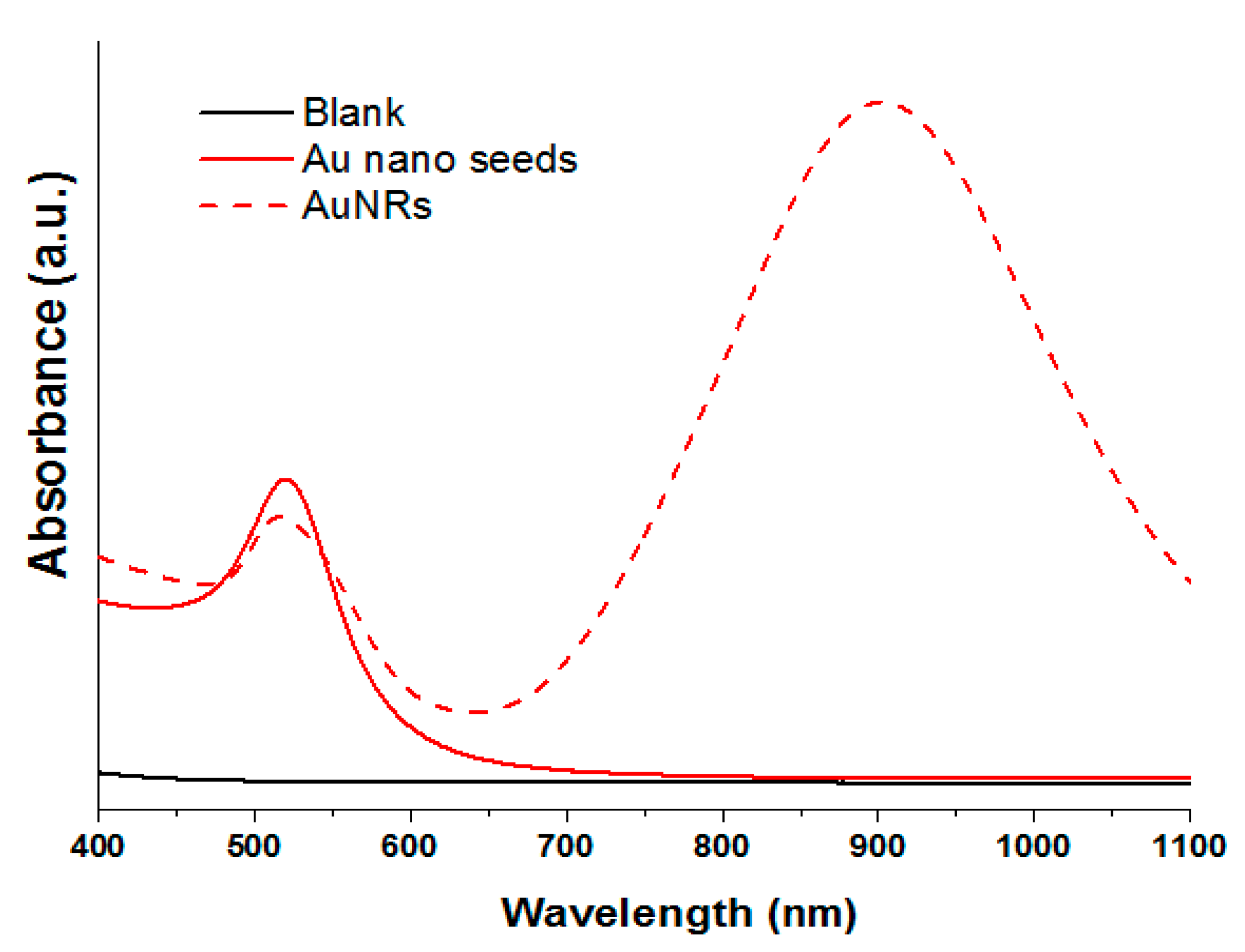
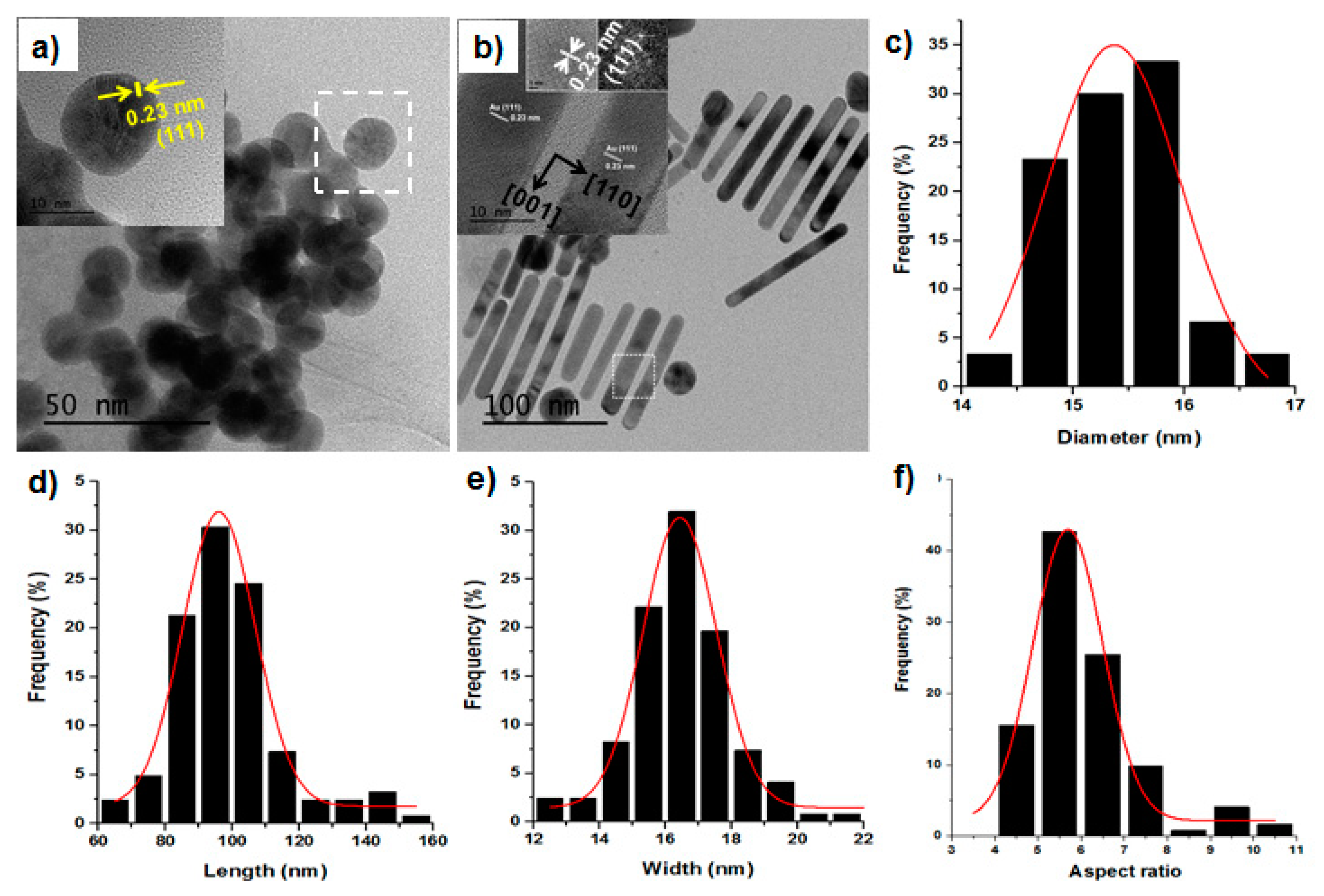
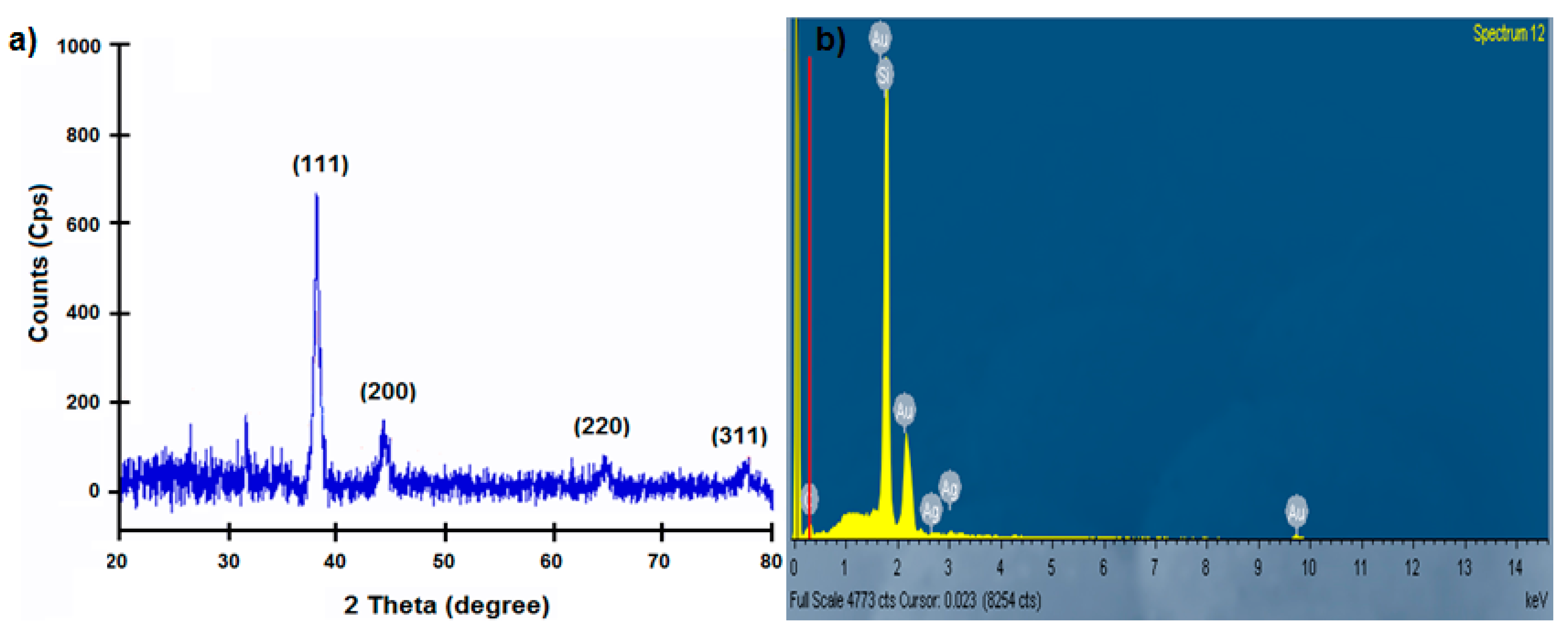
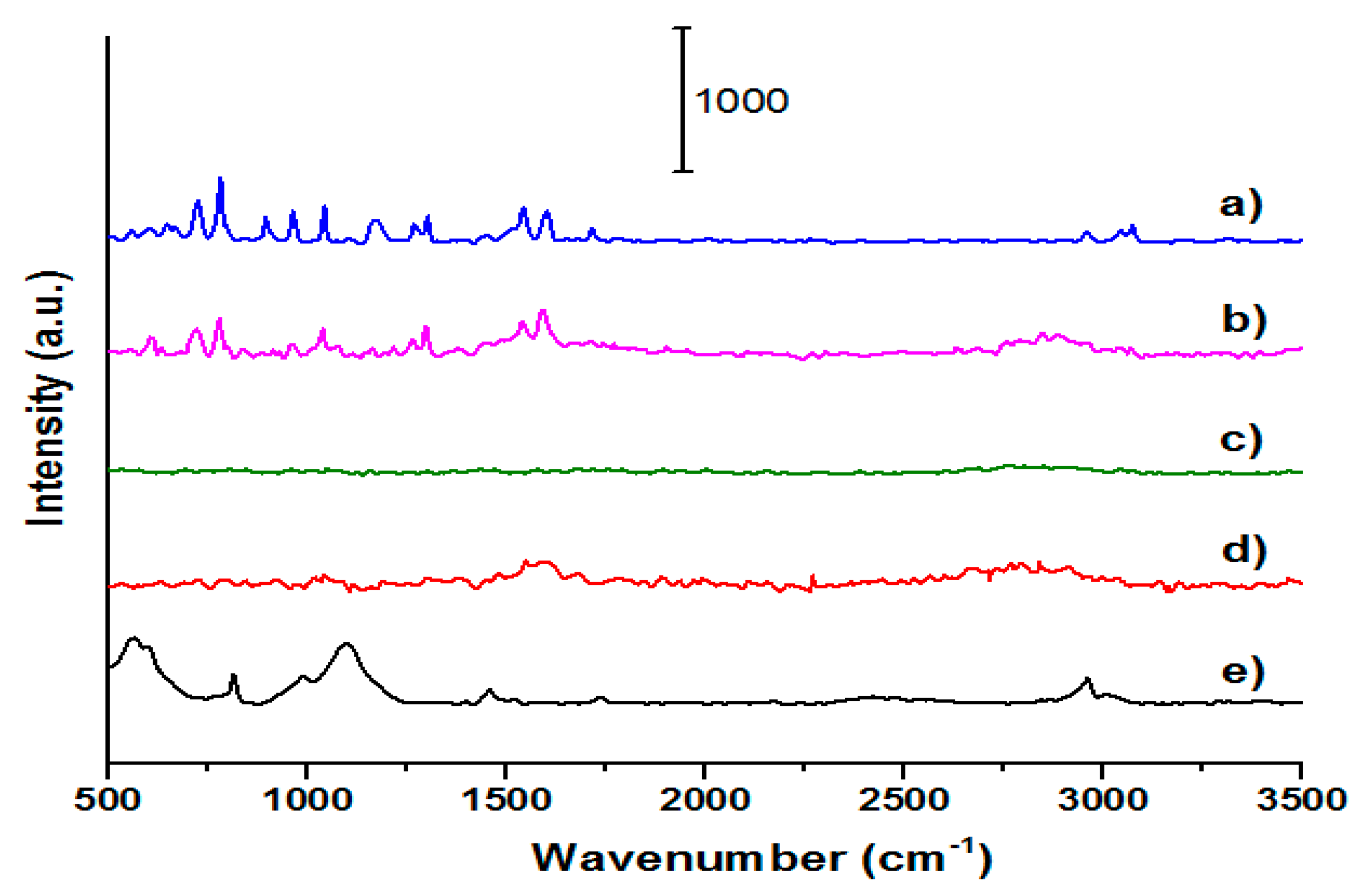

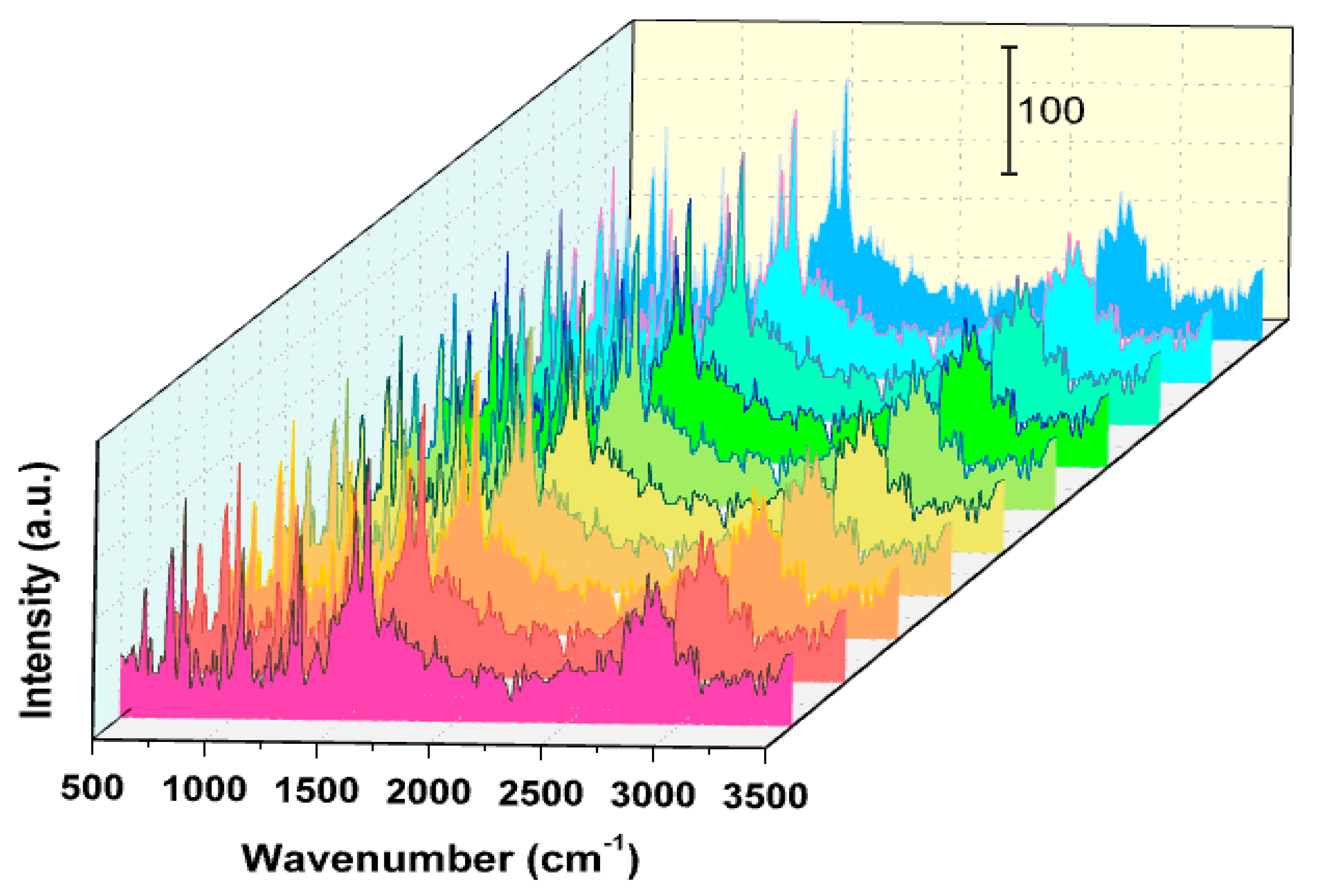
© 2020 by the authors. Licensee MDPI, Basel, Switzerland. This article is an open access article distributed under the terms and conditions of the Creative Commons Attribution (CC BY) license (http://creativecommons.org/licenses/by/4.0/).
Share and Cite
Nguyen Thi Nhat, H.; Le, N.T.T.; Thi Phuong Phong, N.; Nguyen, D.H.; Nguyen-Le, M.-T. Hydroquinone-Based Fabrication of Gold Nanorods with a High Aspect Ratio and LSPR Greater than 850 nm to Be Used as a Surface Plasmon Resonance Platform for Rapid Detection of Thiophanate Methyl. Appl. Sci. 2020, 10, 3654. https://doi.org/10.3390/app10103654
Nguyen Thi Nhat H, Le NTT, Thi Phuong Phong N, Nguyen DH, Nguyen-Le M-T. Hydroquinone-Based Fabrication of Gold Nanorods with a High Aspect Ratio and LSPR Greater than 850 nm to Be Used as a Surface Plasmon Resonance Platform for Rapid Detection of Thiophanate Methyl. Applied Sciences. 2020; 10(10):3654. https://doi.org/10.3390/app10103654
Chicago/Turabian StyleNguyen Thi Nhat, Hang, Ngoc Thuy Trang Le, Nguyen Thi Phuong Phong, Dai Hai Nguyen, and Minh-Tri Nguyen-Le. 2020. "Hydroquinone-Based Fabrication of Gold Nanorods with a High Aspect Ratio and LSPR Greater than 850 nm to Be Used as a Surface Plasmon Resonance Platform for Rapid Detection of Thiophanate Methyl" Applied Sciences 10, no. 10: 3654. https://doi.org/10.3390/app10103654
APA StyleNguyen Thi Nhat, H., Le, N. T. T., Thi Phuong Phong, N., Nguyen, D. H., & Nguyen-Le, M.-T. (2020). Hydroquinone-Based Fabrication of Gold Nanorods with a High Aspect Ratio and LSPR Greater than 850 nm to Be Used as a Surface Plasmon Resonance Platform for Rapid Detection of Thiophanate Methyl. Applied Sciences, 10(10), 3654. https://doi.org/10.3390/app10103654




